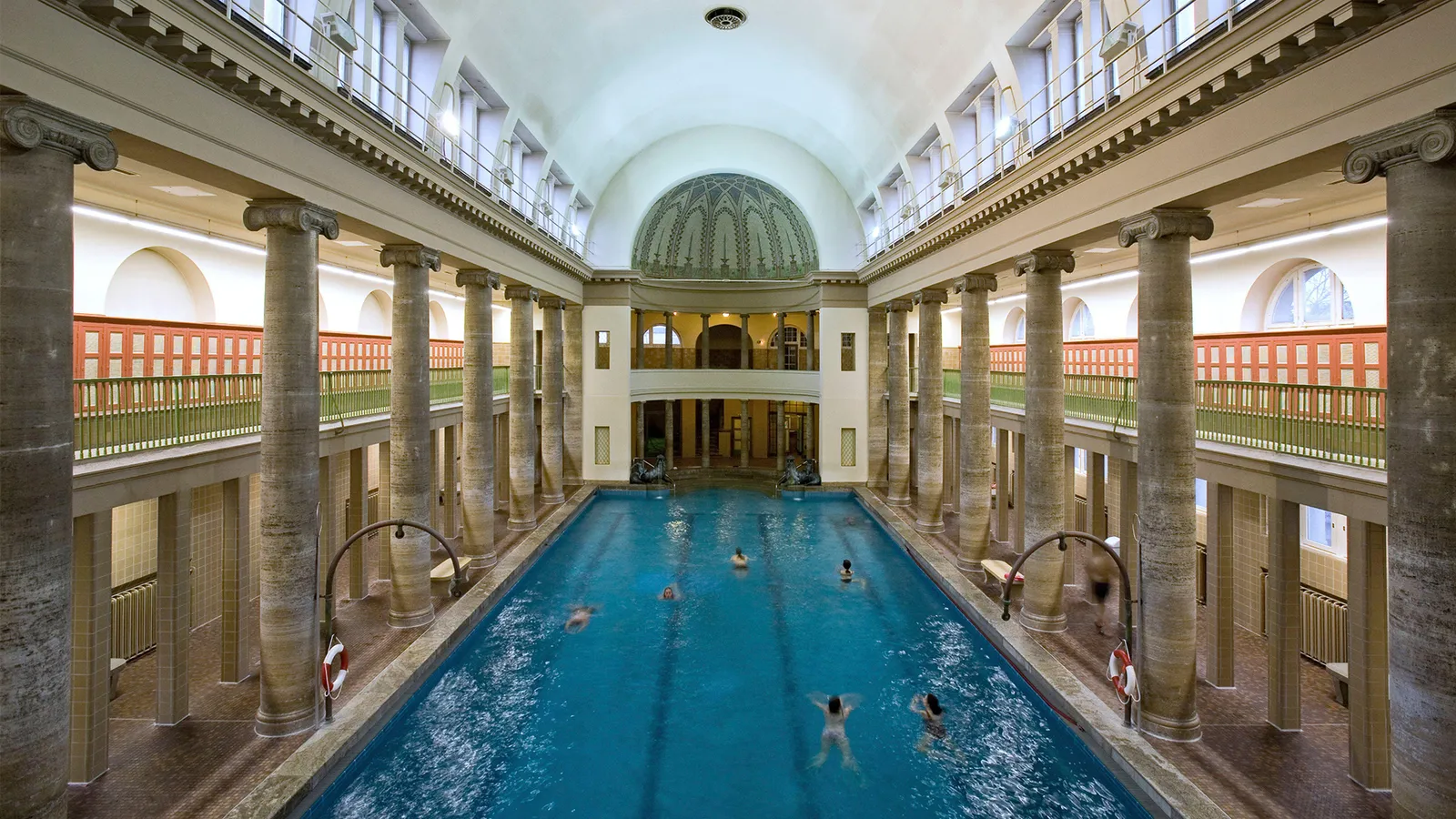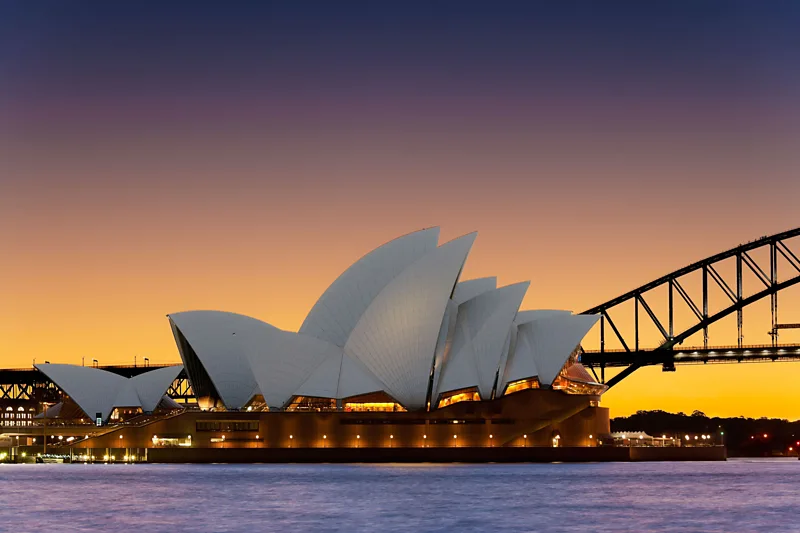The hidden beauty of Berlin's indoor pools
The German capital is dotted with more than 60 public indoor swimming pools, and many of them are so stunning and tranquil they feel like you're swimming in an ornate library.

On a recent November day in Berlin's upscale Prenzlauer Berg neighbourhood, locals in long jackets pushed strollers through the crisp autumn air. Others wrapped themselves in blankets and lingered at outdoor cafes. And down the street, a handful of people gripping swimsuits headed under the stone Neo-Renaissance facade at the Hotel Oderberger Berlin to partake in a beloved, centuries-old local tradition: whiling away the hours at one of Berlin's many eye-catching public indoor swimming pools (Hallenbäder).
Boasting 60 indoor public swimming pools that attract six million visitors each year, Berlin is one of the world's great indoor swimming destinations. And unlike elsewhere, where public pools are more functional than fancy, Berlin's Hallenbäder are veritable cathedrals of late 19th- and early 20th-Century design.
As I followed the crowd inside the Stadtbad Oderberger Strasse, for instance, I noticed the 20m pool was surrounded by decorative tiles, arched windows and ornate detailing on the stone railings that felt more like a Moroccan riad than a public pool. Berlin's indoor pools are also known for being places of relaxation rather than racket. Aside from the occasional splash or sandals tapping against tiles, all was quiet here. As others were quietly doing laps, it felt like I was in a library-turned-swimming pool (without the constant fear of getting shushed).
"It would be impossible not to be fond of swimming and also live in a place like Berlin," said local resident Beata Gontarczyk-Krampe. "It's something that you do very much and very often in Berlin."
For the past 15 years, Gontarczyk-Krampe, who calls herself "a very eager amateur historian" has been researching and writing about Berlin's lesser-known history, publishing two editions of her Berlin Companion books in the process. The history of Berlin's many indoor swimming pools is a topic that's piqued her interest since moving to here from Poland in 2003. And after spending the past 20 years discovering dozens of ornate Hallenbäder hiding in plain sight, she learned that they have a curious history.
Hallenbäder first became popular in Berlin among the wealthier classes in the late 19th and early 20th Centuries as a means to develop higher standards of personal hygiene at a time when few people had baths at home. But as it became clear that poor hygiene spread diseases, the city realised that there were civic and sanitary benefits to broadening the pools' accessibility and granted access to lower classes as well, which is why they are also called Volksbäder, or the "people's pools".
Remarkably, many of the city's Hallenbäder survived the bombing of World War Two. Stadtbad Charlottenburg – the city's oldest indoor pool built between 1896 and 1898 – and Stadtbad Oderberger Strasse are two such examples. But those that were hit, like Stadtbad Moabit, were swiftly restored to their original glory.
"The city did everything it could to re-open them as quickly as possible," Gontarczyk-Krampe explained. "But not so much for swimming as for washing and bathing."
After World War Two, a trip to the pool became less about hygiene and more as an escape from the rubble of an occupied city. These ornate reminders of a better time were the backdrop for many Berliner childhoods. For those children of post-war Germany, spending the afternoon at the pool simply became a matter of tradition, if not obsession.
"Berliners are really among the most swimming-pool crazy people I know," Gontarczyk-Krampe laughed. Just as hordes of Berliners flock to the city's many nearby lakes to swim whenever the weather warms, they also retreat to their local pool as soon as temperatures drop.
"Most of the Hallenbäder are surprisingly full very early in the morning," she said. "All lanes will be taken by the 'Frühschwimmer' or early swimmers." Then there are the weekends, when parents carry massive bags full of snacks and swim gear.
"If you really wanted to hurt Berliners, you would take the swimming pools away," Gontarczyk-Krampe joked. "Whenever anyone says anything about a swimming pool being renovated or closed for three years, there's such an outcry. It's almost touching."
Whether you're a history buff, architecture buff or are simply looking for a place to escape the city's dark winter days, here's our list of Berlin's most stunning indoor pools.
Stadtbad Charlottenburg
Following the demolition of the Moabit Volksbad in 1985, Stadtbad Charlottenburg became the city's oldest surviving indoor swimming pool. Nestled along a quiet side street off Bismarckstrasse, this majestic Gothic-style red-brick building is adorned with captivating water-themed gargoyles. Built during Berlin's population boom in 1898, it served a crucial role in public health, offering bathing facilities at a time when most homes lacked bathrooms. Despite surviving damage in the final days of World War Two and facing demolition threats in 1974, public outcry forced the decision to restore and preserve the facility. In 1982 it received historic preservation protection and remains the first and only Hallenbad in Berlin to have a stainless-steel swimming pool.
Today, Stadtbad Charlottenburg welcomes visitors with an elaborate wrought-iron door leading to the Art Nouveau-style old hall. The facility showcases a neo-Gothic cross vault interior, mesmerising ironwork and murals depicting a pastoral lakeside scene of a naked man and woman relaxing in their natural surroundings.
Stadtbad Neukölln
Nestled in Berlin's dynamic and diverse Neukölln neighbourhood, Stadtbad Neukölln is a time-honoured Neoclassical treasure that seamlessly combines architectural splendour with a rich bathing tradition. Originally opened in 1914, this grand bathhouse was built for up to 10,000 daily visitors and quickly became one of the most celebrated pools in Europe. Architect Reinhold Kiehl designed it in the style of an ancient spa, taking inspiration from Russian-Roman baths that included a domed building with a round plunge pool and a skylight that draws in natural light. A bonus for the ladies: it's reserved exclusively for women on Mondays.
Stadtbad Berlin-Mitte
Also known as Stadtbad Gartenstrase, this pool is anchored in the heart of Berlin's central Mitte (literally: "Middle") district and is a captivating testament to the city's architectural and bathing heritage. The historical Bauhaus bathhouse first opened its doors in 1930, designed under the motto "light, air and sun", and its mullioned ceiling windows offer fantastic views of the winter sky. Two bombs hit the building on 2 January 1945, but immediate action was taken to prevent more significant damage and the pool reopened that June – just a month after the surrender of Nazi Germany. By the end of 1945, Stadtbad Mitte averaged 5,000 daily visitors – perhaps in search of distraction from the reality of post-war Germany. Float on your back in the 50m-long pool and take in the fleeting light of winter in Berlin.
Liquidrom
Located in the massive Brutalism crown-meets-tent Tempodrom on the western-edge of Kreuzberg, Liquidrom is essentially a Berlin club-turned spa. The sleek, modern interior and soft illumination matches a soundtrack that ranges from classical to techno. Unlike the more historical swimming pools, the emphasis here is on saunas and the impressive saltwater floating pool. Perhaps more than anywhere else, this is where travellers can experience Germany's "textile-free" culture head on.
Stadtbad Oderberger Strasse
Tucked into Berlin's well-heeled Prenzlauer Berg neighbourhood, Stadtbad Oderberg Strasse (also known as Stadtbad Prenzlauer Berg) is a captivating fusion of history and modernity. Originally inaugurated in 1902 as a public bathhouse to improve the hygiene of the growing neighbourhood brimming with breweries and factories, this architectural treat underwent extensive renovations after closing in 1986. It reopened in 2016 inside the boutique Hotel Oderberger Berlin with guaranteed public access to the pool. Visitors just have to book a two-hour ticket for €9 and can do so in advance online. Hotel guests can visit for free.
Schwimmhalle Finckensteinallee
Schwimmhalle Finckensteinallee has witnessed many chapters of Berlin's complex history. It's one of the city's few remaining relics of Third Reich Brutalist architecture. Originally constructed in 1938 as an exclusive training facility for the SS, its imposing red-brick exterior and pseudo-Neoclassical style showcase the imagined grandeur of Nazi Germany. Two stone statues of a naked woman and a man holding a sword are on either side of the entrance as if standing guard.
After years of serving different purposes – including being under American control post-World War Two – the pool opened its doors to the public in 2014. The vast hall, adorned with floor-to-ceiling windows, preserves its original scale and aesthetics, with pastel blue and white ceilings adding a touch of vibrancy. Despite its challenging past, the pool now offers a unique blend of history and modern amenities, including a free book exchange, inviting visitors to reflect on its transformative journey. Either way, come prepared to swim, as it's known as a place for sporty swimmers.
-bbc







